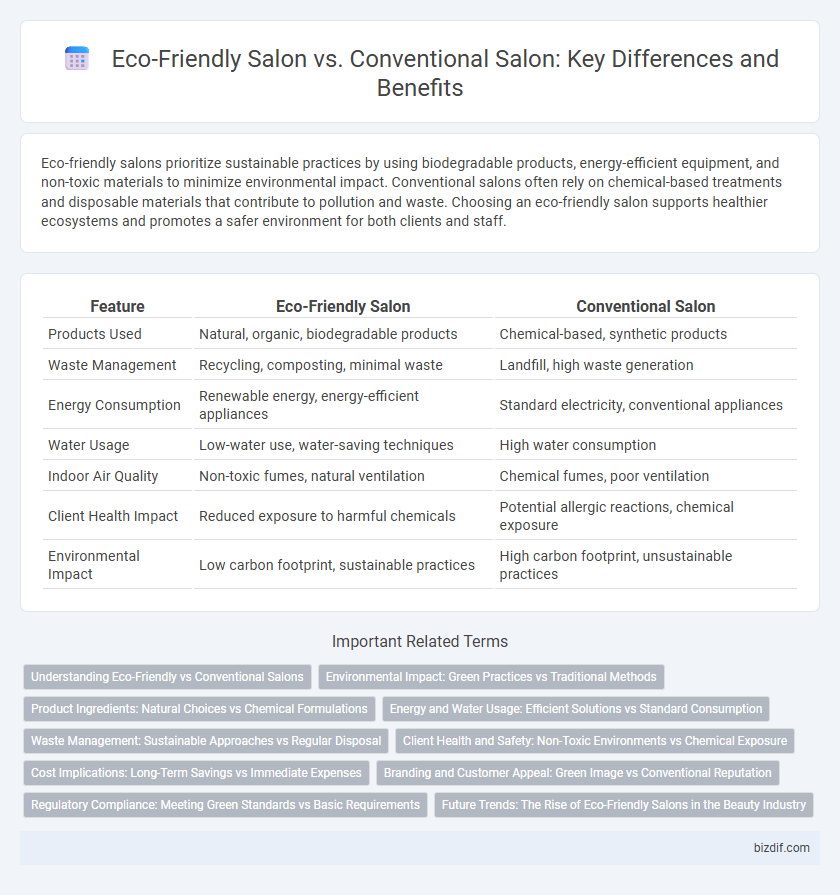Eco-friendly salons prioritize sustainable practices by using biodegradable products, energy-efficient equipment, and non-toxic materials to minimize environmental impact. Conventional salons often rely on chemical-based treatments and disposable materials that contribute to pollution and waste. Choosing an eco-friendly salon supports healthier ecosystems and promotes a safer environment for both clients and staff.
Table of Comparison
| Feature | Eco-Friendly Salon | Conventional Salon |
|---|---|---|
| Products Used | Natural, organic, biodegradable products | Chemical-based, synthetic products |
| Waste Management | Recycling, composting, minimal waste | Landfill, high waste generation |
| Energy Consumption | Renewable energy, energy-efficient appliances | Standard electricity, conventional appliances |
| Water Usage | Low-water use, water-saving techniques | High water consumption |
| Indoor Air Quality | Non-toxic fumes, natural ventilation | Chemical fumes, poor ventilation |
| Client Health Impact | Reduced exposure to harmful chemicals | Potential allergic reactions, chemical exposure |
| Environmental Impact | Low carbon footprint, sustainable practices | High carbon footprint, unsustainable practices |
Understanding Eco-Friendly vs Conventional Salons
Eco-friendly salons prioritize the use of sustainable, biodegradable products made from natural ingredients, reducing environmental impact compared to conventional salons that often rely on chemical-based hair and beauty products. These green salons implement energy-efficient lighting, water-saving fixtures, and waste reduction practices, whereas conventional salons may not focus on resource conservation. Understanding the differences helps consumers make informed decisions about supporting salons that promote health, sustainability, and environmental responsibility.
Environmental Impact: Green Practices vs Traditional Methods
Eco-friendly salons significantly reduce environmental impact by using biodegradable products, energy-efficient lighting, and water-saving techniques, minimizing chemical waste and pollution. Conventional salons often rely on synthetic chemicals, non-recyclable packaging, and energy-intensive equipment, contributing to higher carbon footprints and hazardous waste. Embracing sustainable practices in green salons promotes healthier ecosystems and aligns with growing consumer demand for environmentally responsible beauty services.
Product Ingredients: Natural Choices vs Chemical Formulations
Eco-friendly salons prioritize products made from natural ingredients such as plant extracts, essential oils, and biodegradable substances, reducing exposure to harmful chemicals and minimizing environmental impact. Conventional salons often use products with synthetic chemicals like parabens, sulfates, and phthalates, which can cause allergic reactions and contribute to pollution. Choosing natural-based products supports healthier hair care and promotes sustainability by avoiding toxic residues that harm ecosystems.
Energy and Water Usage: Efficient Solutions vs Standard Consumption
Eco-friendly salons implement energy-efficient lighting, low-power appliances, and water-saving fixtures, reducing overall resource consumption by up to 40% compared to conventional salons. These sustainable practices significantly lower utility costs and carbon footprints while promoting conservation. In contrast, standard salons often rely on outdated equipment that uses excessive electricity and water, resulting in higher operational expenses and environmental impact.
Waste Management: Sustainable Approaches vs Regular Disposal
Eco-friendly salons implement comprehensive waste management systems by recycling hair clippings, refilling beauty product containers, and using biodegradable materials, significantly reducing landfill contributions. Conventional salons often rely on single-use plastics and dispose of chemical-laden residues through regular trash streams, increasing environmental pollution. Sustainable approaches in eco-friendly salons minimize hazardous waste, promote resource conservation, and foster a circular economy within the beauty industry.
Client Health and Safety: Non-Toxic Environments vs Chemical Exposure
Eco-friendly salons prioritize client health by using non-toxic, natural products that reduce exposure to harmful chemicals often found in conventional salons. These environments minimize respiratory irritants, allergic reactions, and long-term health risks commonly associated with traditional salon chemicals like formaldehyde and ammonia. Clients benefit from safer air quality and skin-friendly treatments, promoting overall well-being during salon visits.
Cost Implications: Long-Term Savings vs Immediate Expenses
Eco-friendly salons often require higher initial investments in sustainable products and energy-efficient equipment, leading to increased upfront costs compared to conventional salons. However, the long-term savings from reduced utility bills, lower waste disposal fees, and decreased need for chemical purchases typically offset these expenses over time. Conventional salons may benefit from lower immediate costs but face higher ongoing expenses due to frequent product replacements and potential regulatory fines related to environmental compliance.
Branding and Customer Appeal: Green Image vs Conventional Reputation
Eco-friendly salons differentiate their brand through sustainable practices, attracting environmentally conscious clients who prioritize green living and ethical consumption. This green image enhances customer loyalty and generates positive word-of-mouth, setting these salons apart from conventional salons that often rely on traditional reputation and standard beauty services. Emphasizing eco-friendly certifications and natural product usage boosts appeal among millennials and Gen Z, who increasingly favor brands aligned with environmental responsibility.
Regulatory Compliance: Meeting Green Standards vs Basic Requirements
Eco-friendly salons rigorously adhere to environmental regulations, exceeding basic compliance by integrating sustainable practices such as using non-toxic, biodegradable products and energy-efficient equipment. Conventional salons typically meet only standard health and safety requirements, often neglecting green certifications or eco-friendly waste disposal methods. Meeting green standards in eco-friendly salons showcases commitment to both regulatory compliance and environmental responsibility, appealing to increasingly eco-conscious clients.
Future Trends: The Rise of Eco-Friendly Salons in the Beauty Industry
Eco-friendly salons are rapidly gaining popularity due to increasing consumer demand for sustainable beauty practices and environmentally safe products. These salons prioritize biodegradable packaging, non-toxic ingredients, and energy-efficient equipment, setting a new standard for green innovation in the beauty industry. Future trends indicate a shift towards zero-waste initiatives and renewable resource utilization, positioning eco-friendly salons as leaders in transforming salon culture worldwide.
Eco-Friendly Salon vs Conventional Salon Infographic

 bizdif.com
bizdif.com